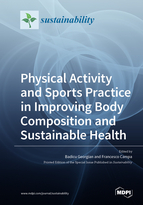Physical Activity and Sports Practice in Improving Body Composition and Sustainable Health
A special issue of Sustainability (ISSN 2071-1050). This special issue belongs to the section "Health, Well-Being and Sustainability".
Deadline for manuscript submissions: closed (15 January 2021) | Viewed by 41182
Special Issue Editors
Interests: physical activity; diet, fitness; sport; quality of life
Special Issues, Collections and Topics in MDPI journals
Interests: anthropometry; bioelectrical impedance analysis; body composition; nutritional factors; exercise testing; growth; sports performance; lifestyle
Special Issues, Collections and Topics in MDPI journals
Special Issue Information
Dear Colleagues,
Analyzing and monitoring body composition and physical activity is an important topic when discussing the benefits of leading a healthy lifestyle because of their influence on health status and physical performance.
Sports practice and a healthy lifestyle result in optimal body composition, therefore positively contributing to improvements in health. The populations where physical activity and habits are most studied are children, the elderly, and athletes. Sports practice has a positive impact on the psychological, cognitive, and physical aspects of children, while also promoting longevity in the elderly. Furthermore, the impact of physical activity and healthy habits on body composition are particularly important in athletes, where maintaining optimal hydration status and particular balance between fat and fat-free mass leads to achieving an elevated level of physical performance.
Contemporary researchers have contributed to the field of physical activity research in the development of new measurement methods and training strategies. The aim of this Special Issue is to show sustainability in new training programs and/or strategies aimed at improving body composition and health status, while highlighting the relationship among these specific parameters throughout longitudinal and cross-sectional studies. The purpose of this research collection is to add information on:
- Effect of physical activity on body composition and benefits of sustaining a healthy lifestyle;
- Exercise programs for improving health-related fitness in young and elderly people;
- New training programs and/or strategies to improve body composition in athletes;
- New evidence for body composition and physical fitness measurement techniques.
The keywords listed below provide an outline of some of the possible areas of interest.
Dr. Badicu Georgian
Dr. Francesco Campa
Guest Editors
Manuscript Submission Information
Manuscripts should be submitted online at www.mdpi.com by registering and logging in to this website. Once you are registered, click here to go to the submission form. Manuscripts can be submitted until the deadline. All submissions that pass pre-check are peer-reviewed. Accepted papers will be published continuously in the journal (as soon as accepted) and will be listed together on the special issue website. Research articles, review articles as well as short communications are invited. For planned papers, a title and short abstract (about 100 words) can be sent to the Editorial Office for announcement on this website.
Submitted manuscripts should not have been published previously, nor be under consideration for publication elsewhere (except conference proceedings papers). All manuscripts are thoroughly refereed through a single-blind peer-review process. A guide for authors and other relevant information for submission of manuscripts is available on the Instructions for Authors page. Sustainability is an international peer-reviewed open access semimonthly journal published by MDPI.
Please visit the Instructions for Authors page before submitting a manuscript. The Article Processing Charge (APC) for publication in this open access journal is 2400 CHF (Swiss Francs). Submitted papers should be well formatted and use good English. Authors may use MDPI's English editing service prior to publication or during author revisions.
Keywords
- Athletes
- Body composition
- Physical activity
- Exercise training
- Hydration status
- Physical fitness
- Older people
- Young people
- Sports performance
- Sustainability







